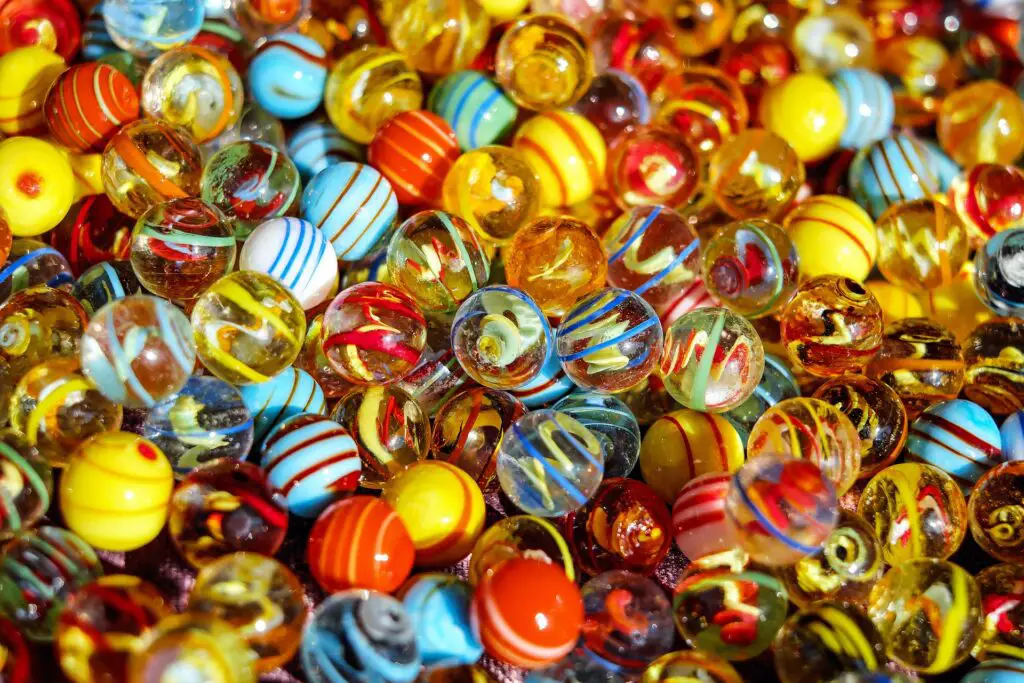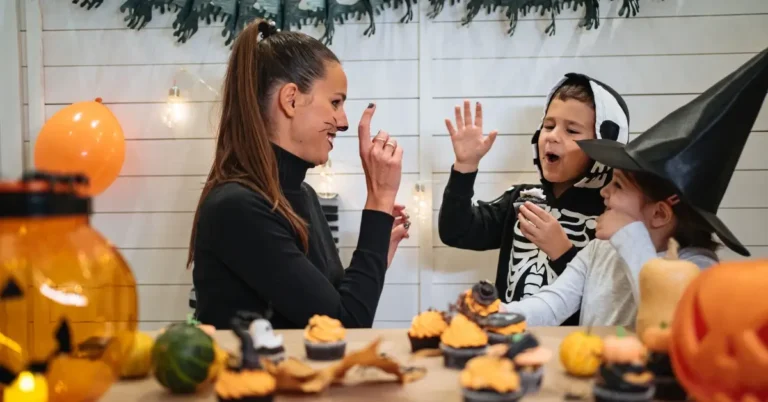Get ready to roll into a world of fun with marble games for kids! These timeless classics offer a simple yet thrilling way to enhance hand-eye coordination, planning, and even a bit of friendly competition. Whether it’s the clink of marbles in a tense match of ‘Ringer’ or the creativity unleashed building intricate marble runs, these games are a hit for playdates, family game nights, or solo play. So, let’s bring back the joy of marbles and watch as your kids flick, roll, and strategize their way to becoming marble masters!
Back to my childhood. It was so much fun to play with marbles. I still love it today. Back then, I also collected marbles and we traded them at school. That’s a beautiful memory for me.
Introduction to Marble Games for Kids
Marble games have been a staple in childhood play for generations. These small, spherical toys offer a world of fun and are perfect for developing dexterity, strategy, and social skills. Whether you’re a parent, teacher, or caregiver, introducing marble games to kids can be a delightful way to engage them in hands-on play.
Here’s a quick start on what you’ll need and the benefits:
- Marbles: A variety of sizes and colors can add to the excitement.
- Space: An open area, indoors or outdoors, where games like Marble Toss can be played.
- Players: Games can vary from single-player challenges to multi-player competitions.
Playing marble games helps enhance motor skills and promotes healthy competition among kids. These games often require a steady hand and a bit of strategy, making them a constructive way to pass the time.
Here’s a simple list of what marble games could offer your child:
- Fun: Endlessly entertaining, with each game being unique.
- Learning: Kids can grasp the concepts of physics and geometry.
- Social: Marble games encourage interaction with others.
From traditional games to modern spins on old classics, the opportunities to play and learn with marbles are immense. Curious about which games to start with? You might consider checking out 20 unique marble games that can be played indoors or outdoors or exploring 34 marble games that include educational twists. Engaging in captivating marble games is a timeless pastime your kids can enjoy. So grab a marble and get rolling!
Types of Marble Games

Marble games are a fantastic way for your kids to have fun while also developing their fine motor skills and strategic thinking. They range from simple activities suitable for young children to more complex challenges that even adults can enjoy.
Target Games
Target games with marbles involve aiming and shooting a marble toward a set of targets, often with points awarded based on accuracy. A popular example is the “Marble Toss,” where you throw marbles into a basket or various labeled compartments, trying to gain the highest score. This can be a great way for your kids to work on their hand-eye coordination.
Racing Games
In racing games, players shoot or roll their marbles down a track to reach the finish line first. The excitement comes from the head-to-head competition, where each player’s skill at propelling their marbles can lead to victory.
Marble Mazes
Marble mazes challenge your kids to guide a marble through a labyrinthine path carved into wood or molded into the plastic. Success in this game requires a steady hand and careful planning as players navigate the marble through perilous turns and traps without it falling off the course.
Creative Building
With creative building, children use marbles to construct and explore. They might build elaborate marble runs using materials like cardboard tubes and wooden blocks or even LEGO pieces, creating paths that twist, turn, and spin. Encouraging your kids to design their marble tracks fosters creativity and problem-solving skills.
Benefits of Playing Marble Games

Playing marble games offers a variety of benefits for children, ranging from improved motor skills to enhanced cognitive and social abilities. These classic games not only provide entertainment but also contribute to developmental growth.
Motor Skills Development
Marble games are a hands-on way to aid in honing fine motor skills and hand-eye coordination. For instance, Mini Marble Golf encourages precision and control as you navigate marbles through miniature courses.
- Dexterity: Picking up and placing marbles develops small muscle movements.
- Coordination: Aiming and shooting marbles require a steady hand and good eye alignment.
Cognitive Benefits
Engaging with marble games can boost a child’s cognitive skills, such as problem-solving and strategic thinking. Through play, kids learn to anticipate the physics of the marble’s movement and plan their next move.
- Concentration: Focusing on the path of the marble can improve attention span.
- Spatial awareness: Understanding how marbles move in space is key when playing marble games for kids.
Social Skills Enhancement
Marble games often involve multiple players, which is perfect for teaching valuable social skills such as taking turns, sharing, and healthy competition.
- Teamwork: Some marble games require collaboration, promoting cooperative play.
- Sportsmanship: Recognizing the importance of fair play and respect for others.
By intertwining these essential skills with fun, marble games serve as a vital part of childhood development.
Setting Up for Marble Games

Setting up the right environment and having the necessary materials is crucial for optimizing the fun and benefits of marble games for kids. Whether you’re playing indoors or outdoors, or using a store-bought or DIY kit, preparation will ensure a smooth and enjoyable game experience.
Playing Indoors vs Outdoors
Indoors: When playing marble games inside, you’ll need a smooth and flat surface, such as a hardwood or tile floor. To get started, clear a sufficient space and ensure it’s free of obstacles. If you’re worried about marbles rolling away, create a contained play area using a shallow box or tray.
- Surface: Choose a smooth, hard surface.
- Boundaries: Set up barriers with tape or use a shallow container.
Outdoors: For outdoor play, a flat area of ground or a patio works best. If you’re drawing a circle for a game of marbles, use chalk for pavement or string for grass areas, aiming for a diameter of about 3 feet for the playing circle.
- Location: Find a level ground or a smooth patio area.
- Circle: Draw the perimeter with chalk or lay down a string for your marble ring.
DIY Marble Game Kits
Creating a DIY Marble Game Kit can be both a fun craft and a great way for kids to learn. With materials you likely have at home, like a cardboard box or egg cartons, you can construct a variety of marble games. Numbered marble rolls and marble obstacle courses are perfect examples of games that can be handcrafted.
- Materials: Gather cardboard, scissors, tape, and markers.
- Construction: Build a ramp or maze for your marbles.
Always supervise the crafting process to ensure safety, and encourage your children’s creativity as they design their personalized marble games.
Safety Tips and Maintenance

When it comes to marble games, your child’s safety is paramount. Regular maintenance ensures the longevity of the game pieces, providing endless fun.
Choosing Age-Appropriate Games
For the little ones in your family, it’s essential to pick marble games that match their developmental stage. Games requiring precise dexterity, like Marble Toss, are more suitable for older children, as small marbles pose a choking hazard for those under the age of three. Always check the game’s recommended age before purchasing.
Caring for Marble Game Equipment
Storage: Keep your marble game equipment in top-notch condition by storing it in a cool, dry place away from direct sunlight which can fade colors. A designated box or pouch will prevent loss.
Cleaning: Marbles can be wiped clean with a soft, damp cloth. Avoid harsh chemicals that might damage them. Regular checks for chips or cracks are crucial; discard damaged marbles to avoid the risk of injury. Remember, well-cared-for equipment ensures a safer game experience for everyone involved.
Frequently Asked Questions

Marble games have been enjoyed by children of various ages for generations. They can help develop fine motor skills and strategic thinking. Here are some common questions to help you introduce the joy of marble play to the young ones in your life.
What are some classic marble games that children can enjoy playing?
Classic marble games like Marble Toss and Ringer are enduring favorites. These games involve simple rules that challenge children to flick or roll their marbles toward targets or into a designated area.
Can you recommend some outdoor marble activities involving marbles for children?
Yes, outdoor activities like marble races, where children roll marbles down a track or through an obstacle course, are great fun. You can also try marble painting, where marbles are rolled in paint and then across the canvas to create art.
How do you play the marble game commonly known as Mancala?
Mancala is played by moving marbles or stones around a board with pits, capturing the opponent’s pieces. The goal is to collect the most marbles in your mancala—the large store at the end of the board. It’s a game of planning and strategy.
Are there any marble games available online that are suitable for young players?
Certainly, there are online marble games designed with young players in mind. These digital versions can simulate classic games, such as marble match-ups, or provide entirely new challenges and interactions.
What are the rules for playing traditional games with marbles?
The rules for traditional marble games vary, but they usually involve drawing a circle or a “ring” in the dirt or on the ground, and players take turns trying to knock each other’s marbles out of the ring or hit a target marble.
Could you suggest some marble games that come with a wooden board?
Certainly, games like Chinese Checkers and Solitaire have versions played with marbles on a wooden board. These beautifully crafted boards are often a favorite for both their tactile feel and the aesthetic appeal they add to gameplay.
If you liked this blog post about the topic: marble games for kids, don’t forget to leave us a comment down below to tell us about your experience with it.






